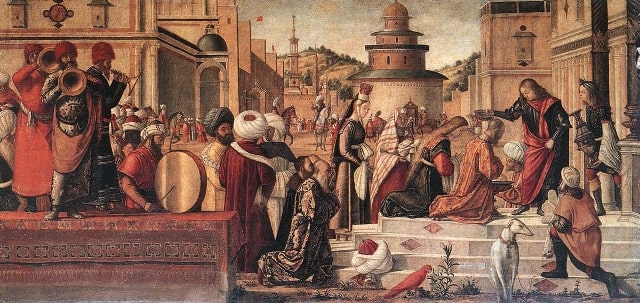The History of Cymbals
When were cymbals invented?

Here we are looking at the history of cymbals and when cymbals were invented. This is taken from my book The Drum: A History which goes deep on all aspects of the drum from the earliest evidence to modern studio recording techniques.
The history of cymbals is a long and interesting one and it started in earnest with one of the oldest companies in the world: Zildjian with their origins being in Turkey.
The area known today as Turkey is an interesting country due to its location between Asia and Europe as well as its history of being occupied by many different civilisations. It is perhaps best known for the music of one of the earliest military bands called the Mehteran, known better as Ottoman Military or Janissary Bands. These groups and the drums that they used made a huge impression on European military bands and ultimately the orchestras that we enjoy today.
It was in Turkey that the modern cymbal was created and perfected, and although many major manufacturers are located elsewhere in the world today, it is the Turkish tradition and history on which many of them are built.
Zildjian being one of the most famous cymbal makers, began with a strong Armenian connection but with its first workshop in Constantinople. Quickly becoming known for their superior sound, Zildjian cymbals were used by Sultan Osman II of the Ottoman Empire for daily rituals and ceremonies with the well regarded Janissary bands.
In fact, the cymbals were so well received that the Sultan in the early 17th century rewarded Avedis with gifts and a great honour. This honour was that the cymbal smith Avedis earned himself the, “name Zilciyan, literally meaning Family or Son of cymbalsmiths or –makers (Zil is “cymbal” or “bell”, ci is “maker”, yan is “family” or “Son of”). The name, under Western influence, eventually altered to Zildjian.”1
Another big name in this market, Sabian, is also a descendant from the very same Zildjian family. Just as the name Zildjian was constructed from three parts, so too was Sabian, although the origins are less historically significant. Sabian’s founder Robert Zildjian formed the name Sabian from the first two letters of his offspring’s names (Sally, Billy, and Andy). Between these two cymbal giants, they enjoy a significant share of world cymbal sales.
If you want to start your drum lessons for FREE click below.
What did Janissary bands use beyond cymbals?
Along with the metallic cymbals, bells, and trumpets, the military bands also employed the rhythms of the kus, nakkare, and davul. The modern nakkare in this setting comprises of two small copper bowls with a skin stretched across them. They are used to add rhythmic colour between the melodic lines and also to signal the beginning of the march.

The davul was a double headed cylindrical drum and the forerunner to the European bass drum. It consisted of a narrow shell and wider heads, which hung in front of the player allowing him to beat each head comfortably with a stick in each hand. Rope tensioning in a V formation was applied to the two membranes, which sat upon wooden shells with counter hoops made from animal skin.
The two heads were from different animals such as lamb and goat, to create a distinction in sound. This was further enhanced by the playing method involving a thick wooden stick in the right hand playing the accented beats whilst a thin rod created a snapping sound with the left hand on the unaccented beats.
Such a drum is depicted by the Venetian painter Vittore Carpaccio in an Ottoman scene from the 1507 painting the baptism of the Selenites.
With these core drums and sparse harmonic accompaniment the Mehteran was clearly percussion heavy, and indeed when trying to stir up enthusiasm on a noisy battlefield, loud rhythms will be more effective than intricate melodies. The music was often improvised but held together by a rhythmic ostinato known as a usul.
The Mehteran existed from around the early 13th century within the Ottoman Empire but the band was, “based on the tradition inherited from their predecessors the Seljuks. The Sljuk Caliph Keykubat III introduced the use of the drums and revels to announce the presentation of a beylic.” 2 And indeed when the drums of these janissary bands are considered, they show a great connection with the neighbouring Arab world. The nakkare is a scaled down version of the ancient lilissu and the davul is a descendant of the Arabic ţabl.
Janissary bands were not just ceremonial and were often used at strategic points in a battle to incite their men and fill the enemy with terror. Such instruments and band formations were passed on to the Europeans primarily through battle, such as when fleeing in defeat and abandoning the instruments thus allowing the enemy to possess and make use of.
If you are interested in learning more about the history of drums and cymbals from around the world check out The Drum: A History.
If you need help choosing your first cymbals then read this cymbal buying guide.
If you want to start your drum lessons for FREE click below.
If you are new to the drumming journey you might have found that one of the hardest things for new drummers is gaining an understanding of the basics and staying motivated. You will come across hurdles as you learn and many new drummers give up because they don’t have a clear path of progression to follow.
This is where drum lessons are so crucial in the early stages because they give you that path of progression as well as teaching you the correct techniques so you don’t learn any bad habits which stunt your progress later down the line.
If you are looking for beginner drum lessons then you are in the right place. Click the image below and you can access the beginner drum lesson course totally free.
- Pinksterboer, Hugo. The Cymbal Book
. (Milwaukee, WI: Hal Leonard, 1992), 139-140.
- Saoud, Rabah. The Arab contribution to music in the Western world. (Manchester, UK: Foundation for Science, Technology and Civilisation (FSTC) Ltd, 2004),





This is only about modern cymbals that we think of in modern music. The oldest percussion instrument ever found (as of 2002) were cymbals. Even before Zildjian. Thousands of years before Zildjian. They were used by women, primarily, both finger cymbals and ceremonial rituals and to reach the Gods or spirits, China, India, Egypt, also had a bowl they strike to produce a bell sound, bells and gongs were common in ancient times. So Zildjian did not invent the first cymbals. Only just the ones we use on our drum sets.